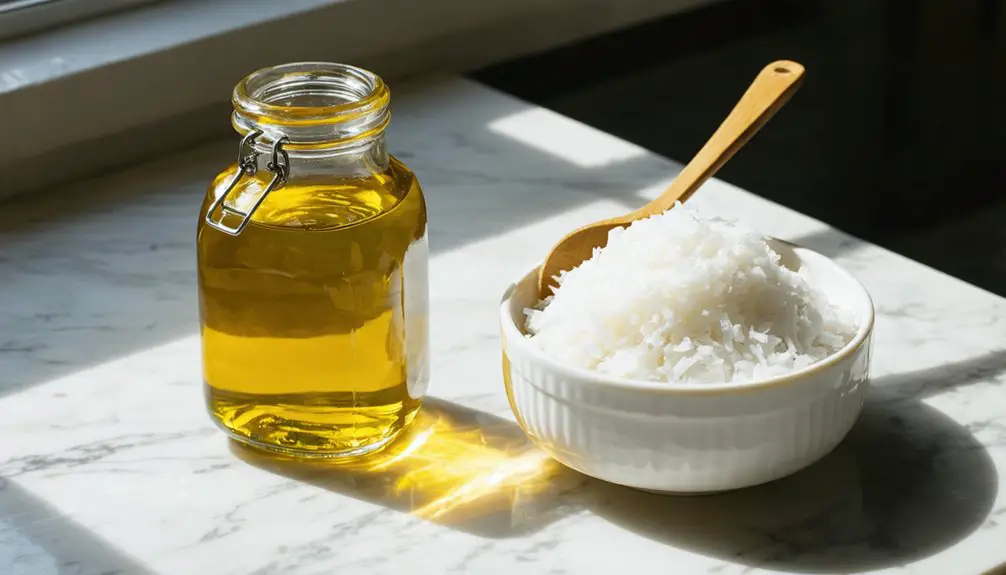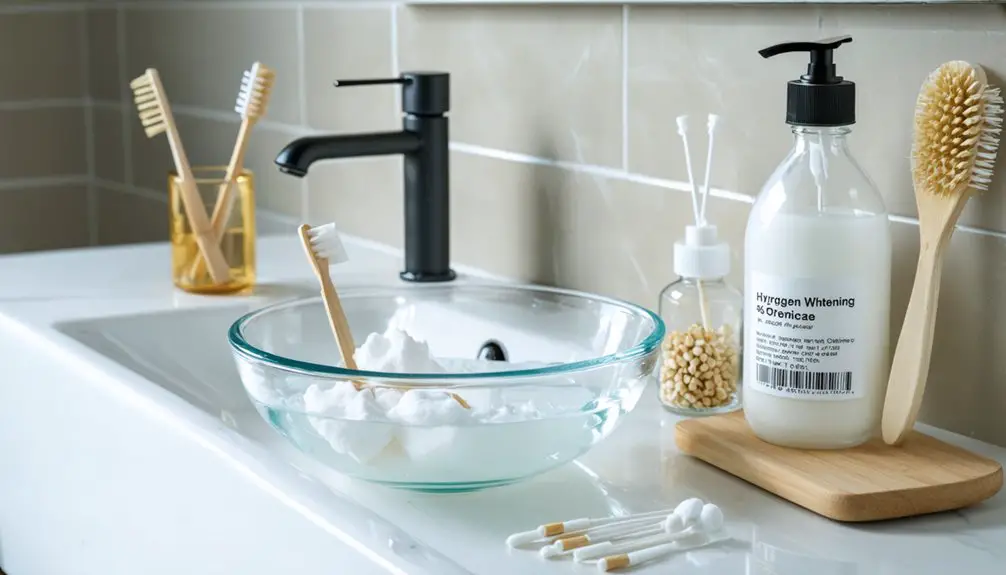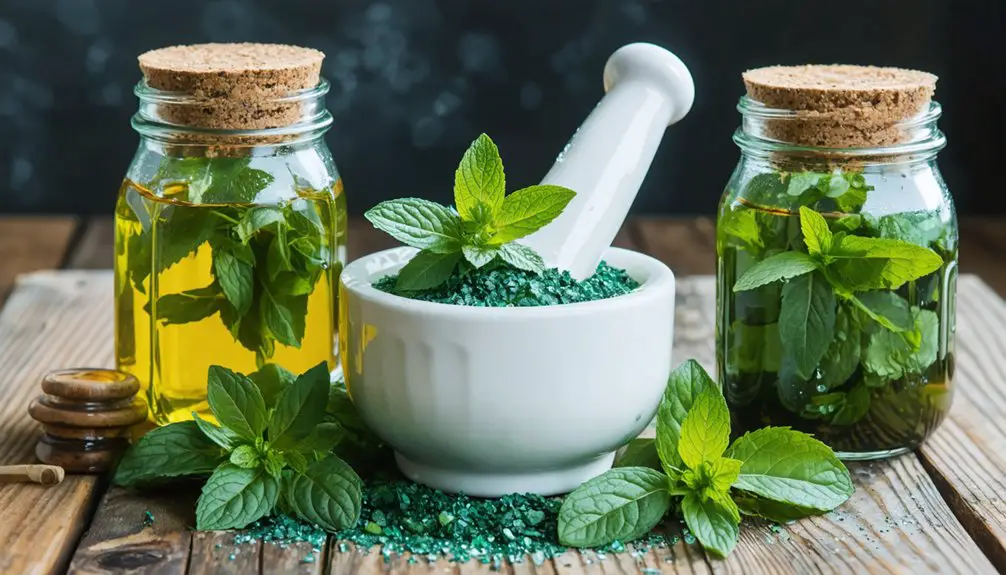You’ll find that oil pulling, an ancient Ayurvedic practice, offers several evidence-backed benefits for your dental health. When you swish oils like coconut or sesame for 15-20 minutes, the process can reduce harmful oral bacteria by up to 20%, improve gum health, and help decrease plaque formation. While it’s not as effective as chlorhexidine mouthwash, it’s a natural, chemical-free complement to your regular brushing and flossing routine. Understanding the proper technique and choosing the right oil will maximize your results.
Key Takeaways
- Oil pulling reduces oral bacterial counts by up to 20% through mechanical and biochemical actions that trap harmful bacteria.
- Regular oil pulling practice can decrease plaque formation and improve gingival health, especially when using coconut or sesame oil.
- The process helps maintain balanced oral pH through saponification, creating natural cleansing compounds that protect teeth.
- Oil pulling may combat tooth decay by specifically targeting Streptococcus mutans bacteria, particularly when using coconut oil’s lauric acid.
- The practice serves as a natural, complementary approach to dental hygiene alongside regular brushing and flossing routines.
The Ancient Practice of Oil Pulling Explained
The ancient practice of oil pulling traces its origins to Ayurvedic medicine over 3,000 years ago in India, where practitioners used natural oils like sesame and sunflower to maintain oral health and overall wellness.
Rooted in ancient Ayurvedic wisdom, oil pulling emerged from India as a time-tested practice for promoting both oral and holistic health.
This traditional technique involves swishing a tablespoon of edible oil in your mouth for 15-20 minutes before spitting it out. Today, coconut oil has become increasingly popular due to its natural antibacterial properties.
Known as kavala graha or gandusha in ancient texts, oil pulling’s Ayurvedic origins reflect a deeper understanding of holistic wellness. The practice connects oral health with other bodily systems through energy channels, suggesting benefits beyond basic dental care.
You’ll find that this method wasn’t just about cleaning teeth – practitioners believed it helped balance doshas (body energies) and remove toxins while treating various conditions from inflammation to headaches. The resurgence of oil pulling in modern wellness circles was sparked when Tummala Kotesware Rao discovered Siberian shamans using oil pulling in the 1990s.
Understanding How Oil Pulling Works
Oil pulling works through a combination of mechanical and biochemical actions as you swish oil around your mouth, creating an emulsified solution that traps harmful bacteria.
The oil’s ability to coat your teeth and gums while attracting bacterial cell membranes leads to effective plaque reduction and bacterial removal, supported by modern research showing a 20% decrease in oral microbial count after 40 days of practice.
While traditional methods emphasized the use of sesame oil, contemporary practices have expanded to include coconut and sunflower oils, which contain beneficial triglycerides that break down into antimicrobial compounds during the pulling process. The process of lipolysis in the mouth helps break down these oils into free fatty acids that may provide antimicrobial benefits. The oil should be discarded after swishing when it becomes thin and milky in appearance.
Mechanism Behind Oil Pulling
Understanding how oil pulling works requires examining several key mechanisms that occur simultaneously during the practice.
When you vigorously swish oil in your mouth, it triggers saponification – an alkaline hydrolysis process similar to soap-making. The oil emulsifies with your saliva, creating bicarbonate ions that cleanse and buffer oral pH. While traditional mouthwash costs more, oil pulling is six times cheaper.
Through mechanical cleansing, the oil’s viscous nature forms a protective barrier over your teeth and gums while preventing bacterial adhesion. The lipid interaction between oil molecules and bacterial membranes enables effective trapping and removal of harmful pathogens. Cold pressed oils like coconut oil are particularly effective because they contain lauric acid compounds that target cavity-causing bacteria.
Additionally, antioxidants in oils like coconut and sesame combat oxidative stress while reducing lipid peroxidation in your oral cavity.
This multi-faceted approach helps maintain ideal oral health and supports a balanced oral microbiome.
Traditional Vs Modern Methods
While traditional oil pulling traces its roots to ancient Ayurvedic practices in India, modern adaptations have evolved to accommodate contemporary lifestyles and scientific understanding.
Traditional practices typically involve swishing sesame or sunflower oil for 15-20 minutes on an empty stomach each morning, with practitioners believing in both oral and systemic health benefits.
Modern adaptations often favor coconut oil due to its antimicrobial properties, with shorter duration options of 5-20 minutes. After the swishing process, the oil should be spat into trash to prevent plumbing issues.
You’ll find today’s approach is more focused on specific oral health outcomes rather than holistic wellness claims. The American Dental Association has not officially endorsed oil pulling as an effective oral health practice.
While traditional practices emphasized strict morning routines, modern adaptations offer flexibility in timing and frequency.
Both methods share the core technique of oil swishing, though modern practices typically integrate with, rather than replace, conventional oral hygiene routines.
Scientific Research Behind Oil Pulling
Scientific research demonstrates that oil pulling markedly reduces oral bacterial counts, with studies showing an average 20% decrease in total microbial populations after 40 days of consistent practice.
A modified gingival index showed significant improvement when comparing oil pulling to non-chlorhexidine mouthwashes.
The practice requires 5 to 20 minutes of swishing the oil in your mouth for optimal results.
You’ll find strong evidence that both coconut and sesame oils exhibit antimicrobial activity against key cavity-causing bacteria like Streptococcus mutans and Lactobacilli.
While clinical trials confirm oil pulling’s bacterial reduction benefits, the evidence for plaque control and gingival health improvement remains less conclusive when compared to conventional treatments like chlorhexidine mouthwash.
Research Findings and Evidence
Research into oil pulling reveals mixed but promising evidence regarding its effectiveness for oral health.
Studies show it can reduce salivary bacterial counts by up to 20% over a 40-day period, with particular effectiveness against cavity-causing bacteria like Streptococcus mutans and Lactobacilli.
While oil pulling demonstrates notable bacterial reduction, its impact on plaque and gingival health is less definitive.
Though some meta-analyses show improvements in gingival health compared to regular mouthwash, it’s less effective than chlorhexidine.
The practice may help reduce caries susceptibility, with studies showing shifts from “marked” to “slight” or “moderate” risk levels.
The mechanism appears to work through both bacterial reduction and mechanical action, potentially aided by increased salivary flow and the oil’s physical properties.
Antibacterial Properties of Oils
Through extensive laboratory analysis, oils used in pulling therapy demonstrate remarkable antibacterial properties due to their unique molecular composition. The antibacterial efficacy stems from specific compounds like lauric acid in coconut oil and bioactive elements in sesame oil, which directly target harmful oral pathogens.
The oil viscosity creates a protective barrier while mechanical swishing action enhances bacterial removal.
- Fatty acids disrupt bacterial cell membranes, causing pathogen death
- Saponification produces soap-like molecules that emulsify and trap bacteria
- Antioxidants inhibit bacterial metabolism and biofilm formation
- Physical barrier prevents bacterial adhesion to tooth surfaces
These mechanisms work together to reduce colonies of *Streptococcus mutans*, *Lactobacilli*, and *Candida albicans*, effectively lowering your risk of dental caries and gum inflammation.
Best Oils to Use for Oil Pulling
Five key oils stand out as ideal choices for oil pulling, each offering unique therapeutic benefits for oral health. Coconut oil leads in popularity due to its potent antibacterial action against Streptococcus mutans, while sesame oil provides traditional Ayurvedic benefits through its anti-inflammatory properties.
Your oil selection might include sunflower oil, which combats plaque with vitamin E and omega-6 fatty acids, or neem oil, particularly effective for receding gums. Mustard oil improves gum circulation with its warming properties.
For best results, choose high-quality, cold-pressed organic oils that retain maximum therapeutic compounds.
Consider your flavor preferences when selecting oils – sunflower offers a milder taste while maintaining effectiveness. Store your chosen oil away from heat and light to preserve its potency.
Step-by-Step Guide to Proper Oil Pulling
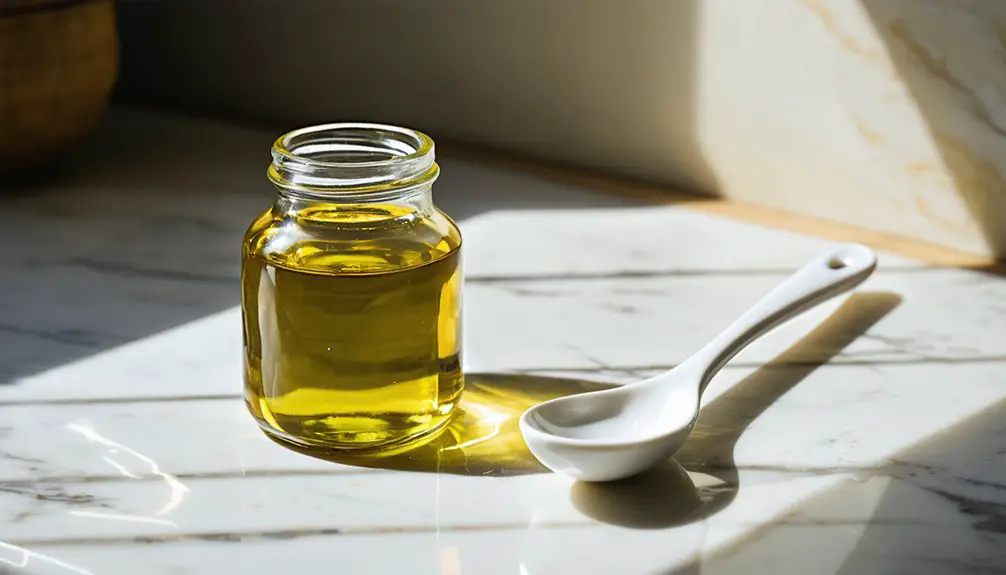
To maximize the benefits of oil pulling, following proper technique is essential for best results. Your daily practice should focus on proper timing, consistent swishing motions, and careful post-procedure steps to achieve peak oral health outcomes.
Mastering oil pulling technique is key to unlocking its full potential, requiring dedication to proper form and careful attention to procedure.
- Measure one tablespoon of fresh oil (or start with 1-2 teaspoons if you’re new to oil pulling techniques).
- Swish gently but thoroughly for a 15-20 minute duration, ensuring the oil reaches between teeth and along gumlines.
- Pull the oil through your teeth using light suction while maintaining steady, controlled movements.
- Dispose of the oil in a trash receptacle, then rinse thoroughly with warm salt water before brushing.
Remember to perform this ritual in the morning before eating or brushing, and maintain an upright position throughout the process for safety and effectiveness.
Benefits and Limitations for Dental Health
Following proper oil pulling technique paves the way for understanding its documented benefits and constraints in dental health.
You’ll find that oil pulling can reduce oral bacterial counts by roughly 20% through regular practice, particularly affecting Streptococcus mutans and Candida albicans. This practice may improve your gingival health and decrease plaque formation, though not as effectively as chlorhexidine mouthwash.
While oil pulling shows promise in reducing dental caries susceptibility and shifting caries risk classifications from marked to moderate, it shouldn’t replace your standard dental hygiene practices.
Current evidence suggests it works best as a complementary approach to regular brushing, flossing, and professional dental care.
Remember that most studies show limited long-term data, so maintain realistic expectations about oil pulling’s role in your oral health routine.
Safety Considerations and Precautions
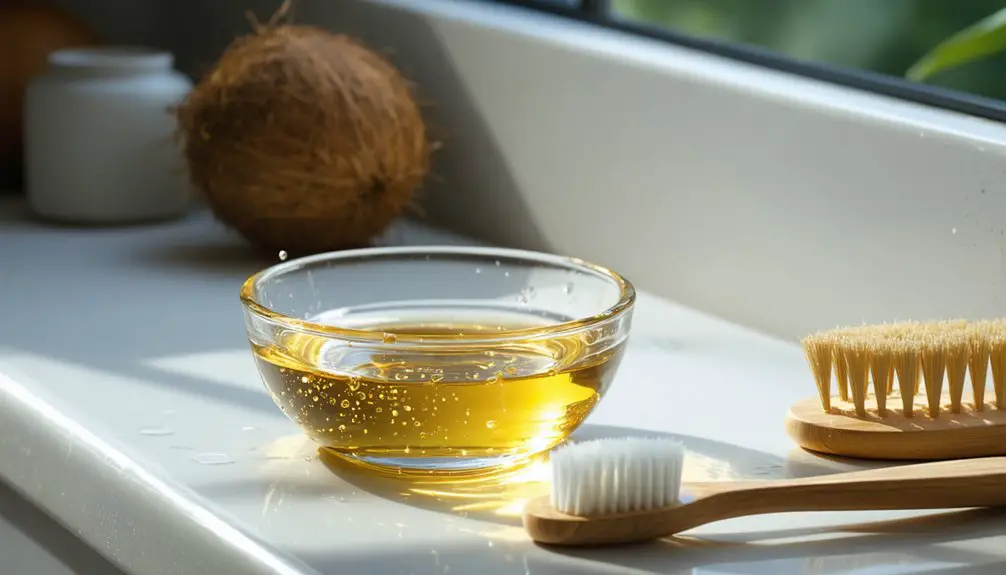
While oil pulling offers potential benefits for oral health, understanding its safety considerations is essential for avoiding adverse effects.
Before starting this practice, you’ll need to follow specific safety guidelines to protect yourself from potential risks.
- Don’t swallow the oil during or after pulling, as it contains concentrated bacteria that could cause stomach upset or more serious complications.
- You’ll need to avoid this practice if you have TMJ disorders, jaw pain, or swallowing difficulties.
- Limit your oil pulling sessions to no more than 20 minutes to prevent muscle strain.
- Always spit the used oil into a trash can, not sinks or toilets, to prevent plumbing issues.
Remember to consult your dentist before starting oil pulling, especially if you have existing dental conditions or orthodontic appliances.
This practice should complement, not replace, your regular oral hygiene routine.
Comparing Oil Pulling to Traditional Oral Care
Understanding how oil pulling compares to traditional oral care methods helps you make informed decisions about your dental hygiene routine.
While oil pulling demonstrates antibacterial properties and can reduce plaque similar to chlorhexidine mouthwash, it requires 15-20 minutes of swishing compared to the quick 2-minute brushing routine.
Oil pulling matches mouthwash in fighting bacteria, but demands significantly more time than standard brushing for comparable results.
Traditional brushing and flossing remain the most effective methods for maintaining oral health, particularly for cleaning between teeth.
Oil pulling can’t replace these mechanical cleaning benefits but serves as a beneficial supplement to your oral hygiene regimen.
The practice shows promise in reducing gum inflammation and bad breath while offering natural stain removal properties.
However, you’ll need to weigh the time investment and practical challenges against the benefits, as oil pulling requires more dedication and careful disposal compared to standard dental care methods.
Expert Opinions and Clinical Studies
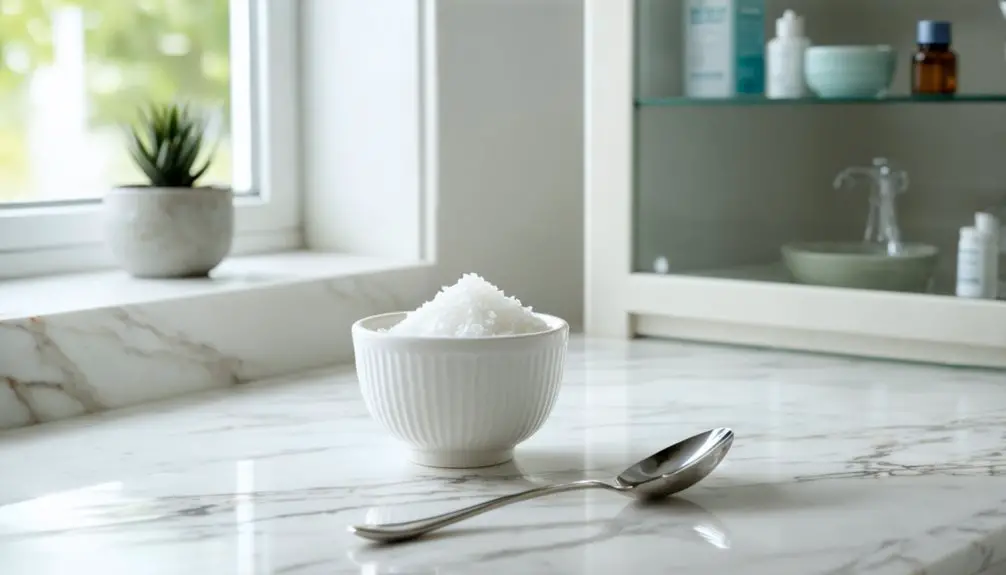
Scientific evidence paints a nuanced picture of oil pulling’s effectiveness through meta-analyses and clinical trials.
Expert evaluations indicate potential benefits, though results vary across studies. Clinical insights reveal that while oil pulling isn’t as effective as chlorhexidine for plaque control, it shows promise for bacterial reduction and gingival health.
- Meta-analyses demonstrate a significant reduction in bacterial colony counts, with an average decrease of 17.55 compared to control groups.
- Studies confirm antibacterial action against key pathogens like Streptococcus mutans and Candida albicans.
- Research suggests oil pulling creates a soap-like effect through saponification, helping neutralize acids.
- Clinical trials show improved gingival health markers, likely due to reduced bacterial load and biofilm disruption.
Frequently Asked Questions
Can Oil Pulling Help With Sensitive Teeth and Gums?
You’ll find oil pulling can help reduce sensitive teeth and improve gum health by decreasing harmful bacteria, lowering inflammation, and supporting healthier gum tissue through its antimicrobial properties.
Is Oil Pulling Safe During Pregnancy or While Breastfeeding?
Looking to maintain oral health during this special time? You’ll be glad to know oil pulling is safe during pregnancy and breastfeeding when using food-grade coconut, sesame, or sunflower oils – just don’t swallow.
Does Oil Pulling Interfere With Dental Fillings or Crowns?
You can safely practice oil pulling with dental restorations, as it won’t damage properly placed fillings or crowns. Still, use gentle swishing techniques and maintain regular dental hygiene for ideal effectiveness.
How Long Should You Wait to Eat After Oil Pulling?
After your oral detoxification session, you’ll need to wait 15-20 minutes before eating to guarantee ideal post pulling routine benefits. Rinse thoroughly with water before consuming any food or beverages.
Can Children Practice Oil Pulling Safely?
You shouldn’t let children practice oil pulling due to safety concerns. Instead, focus on proven children’s dental health practices like brushing and flossing. If considered, consult your pediatric dentist first.
References
- https://pmc.ncbi.nlm.nih.gov/articles/PMC9602184/
- https://onlinelibrary.wiley.com/doi/10.1111/idh.12725
- https://pmc.ncbi.nlm.nih.gov/articles/PMC5654187/
- https://www.todaysrdh.com/oil-pulling-is-it-worth-the-effort/
- https://www.mouthhealthy.org/all-topics-a-z/oil-pulling
- https://www.keekooralcare.com/blogs/news/90420230-the-history-of-oil-pulling-the-short-version
- https://drgingers.com/the-ancient-practice-of-oil-pulling-modernized-for-your-convenience/
- https://handsofhopechiropractic.com/blog/oil-pulling
- https://www.menshealth.com/health/a19530953/oil-pulling/
- https://en.wikipedia.org/wiki/Oil_pulling
